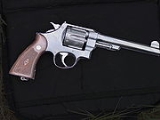
Smith & Wesson Triple Lock
Encyclopedia
- For the feature of the Liberal Democrats democratic structure see Triple Lock mechanism (Liberal Democrats)
The Triple lock, officially the Smith and Wesson .44 Hand Ejector 1st Model 'New Century', is a double action revolver
Revolver
A revolver is a repeating firearm that has a cylinder containing multiple chambers and at least one barrel for firing. The first revolver ever made was built by Elisha Collier in 1818. The percussion cap revolver was invented by Samuel Colt in 1836. This weapon became known as the Colt Paterson...
. It was and is considered by many, including handgun enthusiast and expert Elmer Keith
Elmer Keith
Elmer Keith was an Idaho rancher, firearms enthusiast, and author. Keith was instrumental in the development of the first magnum revolver cartridge, the .357 Magnum, as well as the later .44 Magnum and .41 Magnum cartridges.-Personality and life:Keith's trademarks were his cigars, his ten-gallon...
, to be the finest revolver ever made.
Its popular name refers to its extra (third) locking lug on the cylinder crane. This extra locking mechanism was deemed necessary due to the increased power of the .44 Special
.44 Special
The .44 Special or .44 S&W Special is a smokeless powder center fire metallic cartridge developed by Smith & Wesson in 1907 as the standard chambering for their New Century revolver, introduced in 1908.-Development history:...
cartridge (a lengthened .44 Russian
.44 Russian
The .44 Russian, also known as the .44 S&W Russian, is a blackpowder center fire metallic revolver cartridge developed by Smith & Wesson in 1870...
, and itself the parent of the .44 Magnum
.44 Magnum
The .44 Remington Magnum, or simply .44 Magnum, is a large-bore cartridge originally designed for revolvers. After introduction, it was quickly adopted for carbines and rifles...
), first chambered in the Triple Lock.
The .44 is part of the model name, regardless of the actual chambering of any individual revolver, and Hand Ejector is to differentiate the new design from Smith and Wesson's earlier top break revolvers. These 19th century designs had an automatic ejector mechanism actuated when the frame was tipped up. The newer Hand Ejector models required the user to depress a plunger to eject spent casings. The New Century designation was in recognition of its status as Smith and Wesson's first 20th century design.
It was only manufactured between 1908 and 1915, for a total of 15,376 revolvers, a stock that sold out completely by 1917. It was replaced by a .44 Hand Ejector 2nd Model, most visibly different in lacking the ejector shroud and third locking lug.
Smith & Wesson changed the design for several reasons: the British and Canadian military purchased the triple lock in large quantities for the Great War, chambered in .455 Webley
.455 Webley
.455 Webley is a British handgun cartridge, most commonly used in the Webley top break revolvers Marks I through VI.The .455 cartridge was a service revolver cartridge, featuring a rimmed cartridge firing a .45 bullet at the relatively low velocity of 650 ft/s...
, and pressed for the removal of the third locking lug and shroud due to concerns the precision mechanism would collect dirt and malfunction. Additionally, the change simplified manufacturing, allowing Smith and Wesson to drop the price of the gun $2, from $21 for the 1st Model to $19 for the 2nd Model. The ejector shroud was reintroduced in 1926, with the Hand Ejector 3rd Model, but the Triple Lock feature was never used again.

